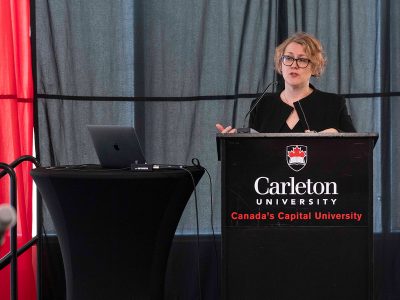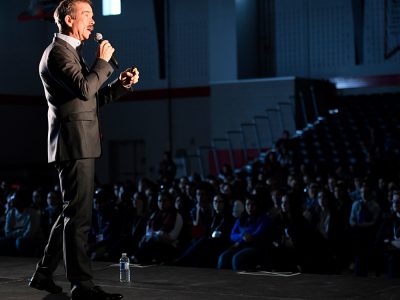By Leah Coppella
Photos by Chris Roussakis
Rowan Thomson’s office is unassuming for a Canada Research Chair in Radiotherapy Physics.
She has two computers, where she pulls up diagrams to better explain her vital cancer research. A drawing by her son is on the wall.
Thomson, a professor at Carleton University’s Laboratory for Radiotherapy Physics and the Medical Physics Group, has been doing research to improve cancer radiation treatments since 2007.
Today, one in two Canadians are expected to develop cancer in their lifetime. More than half of the patients will undergo radiation therapy as part of their treatment. Advancing radiation therapy makes it more effective and accessible.
Specifically, Thomson is working on a calculation for estimating correct radiation dose.
“We develop tools to do accurate calculations and then work on applying them while looking at outcomes.”
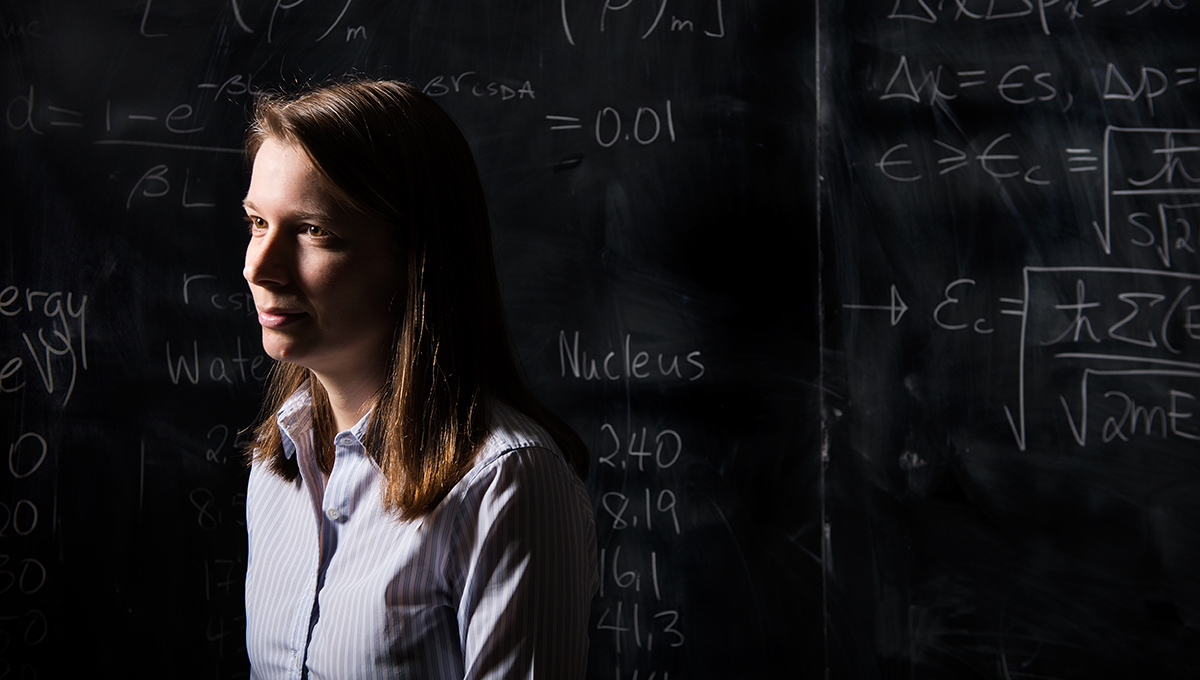
A Winding Path to Medical Physics
Thomson’s journey toward medical physics wasn’t a straight line. In fact, she studied everything from black holes to superstring theory to get there.
After completing an undergraduate degree at Carleton – a double honours program in math and physics – she attended graduate school at the University of Waterloo and Perimeter Institute for Theoretical Physics, an independent research centre.
Thomson finished a PhD in 2007, where she studied black holes to understand how two different theories in physics can help us solve more equations.
“If you watch The Big Bang Theory show, I did similar things to what Sheldon does,” Thomson laughs.

Rowan Thomson with Carleton President Benoit-Antoine Bacon
Her PhD was complex. Thomson used superstring theory to understand quarks and gluons in the early universe.
She explains that everything in the universe is made up of atoms which contain a nucleus with protons and neutrons. These protons and neutrons are made up of things called quarks, which are stuck together by gluons. Quarks and gluons are described by a theory called quantum chromodynamics (QCD).
Superstring theory attempts to make a connection between quantum mechanics and general relativity. Some have claimed that string theory is a step toward discovering the theory of everything (TOE), meaning that this one mathematical model can accurately describe all matter. String theory argues that fundamental particles (electrons and quarks) in an atom are one-dimensional lines, or “strings.”
Thomson used a mapping from string theory to QCD-like theory in her PhD to investigate connections between the two. Using different theories allowed her to solve equations using one theory and then map the results back to the other.
This is where black holes come into play. She used systems of black holes as a model to understand the theories better.
Her work during her PhD prepared her for what would come years later. She still spends time in computational physics and calculations, but for a very different application, specifically tackling cancer radiotherapy.
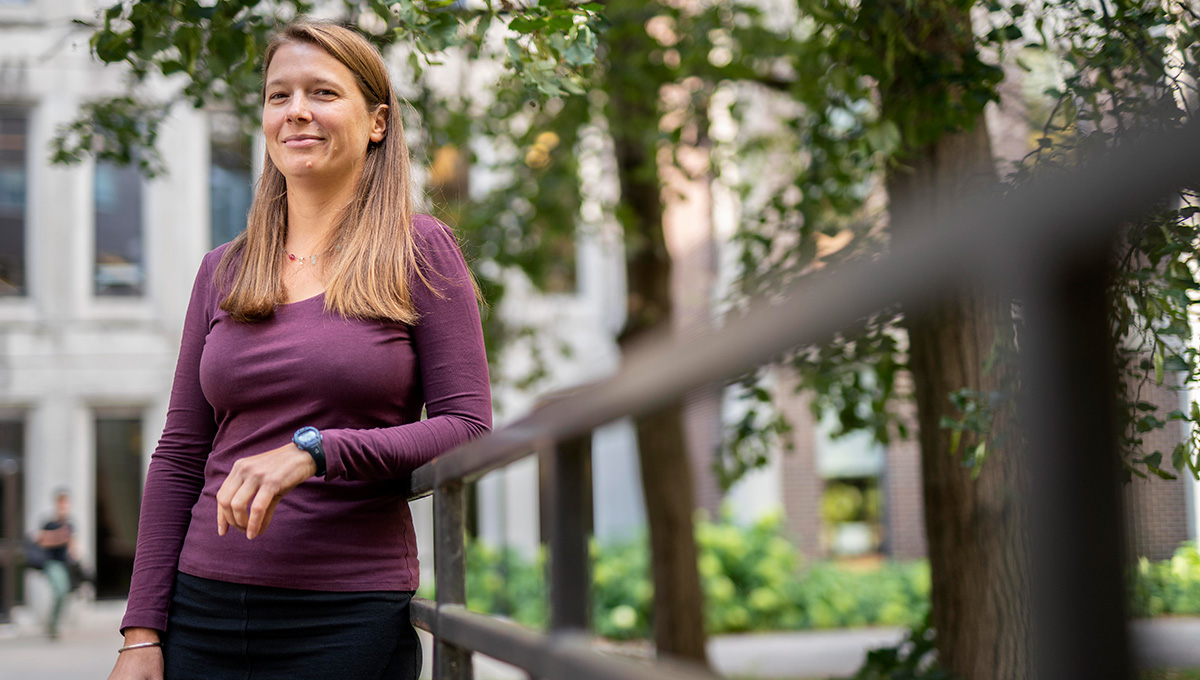
From the Secrets of the Universe to the Intricacies of Cancer
Thomson explains that some cancer treatments use external radiation sources, such as with a linear accelerator (a machine that externally rotates around the patient). Others use internal sources, such as brachytherapy, a radiation treatment that she’s been working on extensively in the last year.
Brachytherapy is a widely-used radiation treatment involving radioactive sources within or near a tumour.
“These sources are implanted permanently in the prostate, or whatever area the tumour is in,” she says.
Evaluations of doses needed to treat cancer are critical for planning and assessing treatments; however, hospital calculations are quite often inaccurate.
“Instead of thinking about a patient, they’ll imagine their patient as a bucket of water, so if they know doses about one of these sources, they’ll add up the dose distributions for the different sources,” Thomson says. “It’s consistent around the world and very fast, but it can also be inaccurate.”
Although brachytherapy has been around for a long time, Thomson’s research is entirely new.
She and her team have been developing egs_brachy, a fast, accurate dose calculation code for brachytherapy. It’s an open-source software which is continuingly being developed and implemented for clinical dose evaluations.
The team have specifically been working on breast brachytherapy treatments with scientists in British Columbia.
“The sources are implanted in a breast after a lumpectomy has taken place and the patient has healed from that surgery.”
Historically, patients would go to a cancer treatment centre every day for a month to undergo external radiation treatment.
“With this treatment, they go in one day. It’s an outpatient procedure, local anesthetic, the radiation sources are implanted in the breast and then they can go home the same day.”
Thomson says the treatment offers the same outcomes or better than external radiation. It’s also incredibly cost-effective.
She has also researched the correlation of cold spots – where radiation doses have been too low – with treatment failures.
Thomson holds up an X-ray of a man’s prostate, identifying a specific region where the tissue has calcified. The dose was way too low, leading to a possible treatment failure.
“They didn’t know that was happening because their dose calculation was so bad,” she says, “So this is the whole motivation for these accurate calculations.”
Thomson says that the rewarding aspect of her work is advancing people’s cancer treatments, but day to day, she takes the most pride in helping students become the best versions of themselves.
“I love seeing them go out and do all sorts of interesting things in their lives,” she says. “That’s very rewarding, and it’s the nearest and most direct to me.”
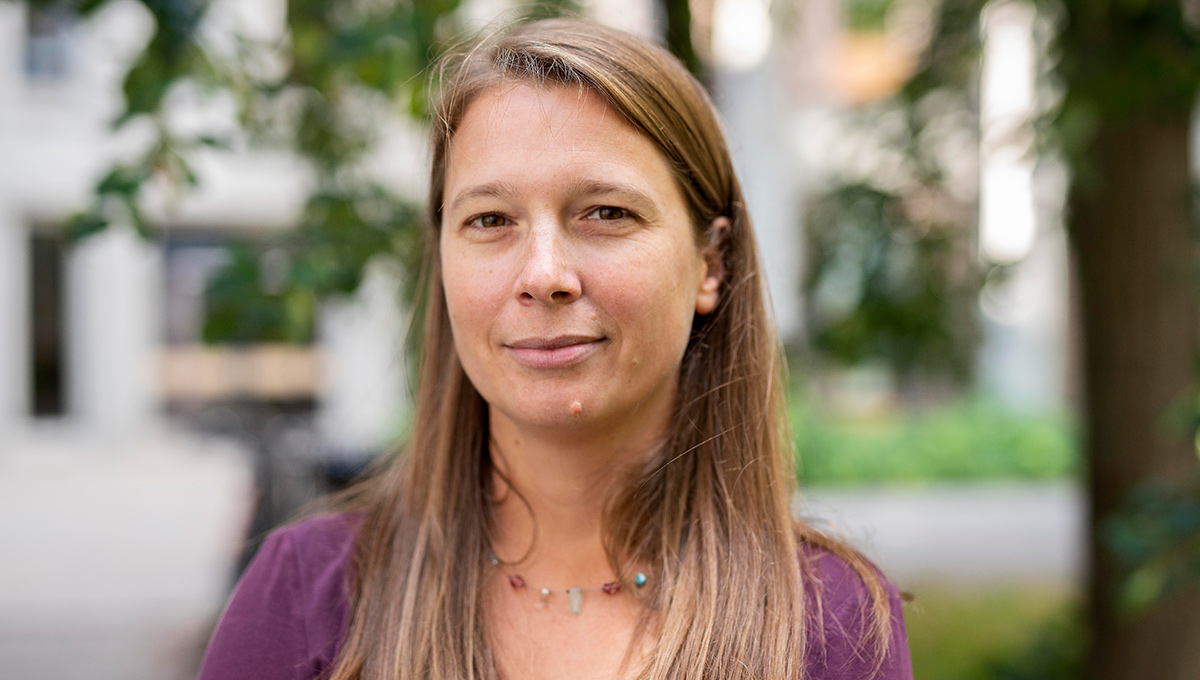
Improving Awareness About Women in Physics
Thomson has also been doing a lot to improve awareness about women in physics, where numbers are still low.
“In my first year of teaching, I had a second-year class with 50 students and there were three women,” she says. “The next class I taught had fewer students, but there were no women.”
Thomson says promoting women in physics is a positive change that will benefit everybody. During her schooling, she only ever had two female professors. And as a resident at the Perimeter Institute, she was often the only woman at meetings or seminars.
In an article she wrote for The Conversation last year, she recalls that her PhD office was shared with other male colleagues, where joking jabs were made about Thomson getting the “secretary’s desk.’’
A striking moment for Thomson was speaking with a highly-respected scientist after Donna Strickland’s Nobel Prize was announced. The scientist expressed surprise that another renowned male optics expert had not been selected, “maybe because he was not a woman.”
Thomson is proud to be part of Carleton’s physics faculty, where there are five women, more than 20 per cent of the faculty.
“I have a lot of ideas of things we can do, including here at Carleton,” she says. “And I’m just getting started.”
While Thomson is starting to be a vocal proponent for equity, diversity and inclusion, others are already talking about how Thomson’s research can be applied to other fields that involve radiation, like nuclear medicine and diagnostic imaging.
And thanks to Thomson’s groundbreaking research, her Canada Research Chair status since 2013 has recently been renewed.
She believes her success is a combination of hard work and discovering what she loves to do.
“Find what you love. And then have the guts to go for it,” Thomson says.
“I think as a society, if more people can figure out what they like, we’ll be happier . . . and more productive.”
Thursday, November 14, 2019 in Faculty of Science, Physics, Research
Share: Twitter, Facebook

